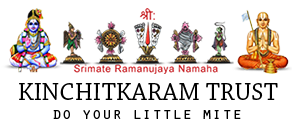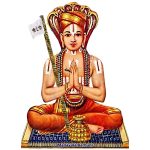Srimathe Rangaramanuja Mahadesikaya Namaha
Srimathe Sri Varaha Mahadesikaya Namaha
Sri Velukkudi Krishnan Swamy Thiruvadigaley Sharanam
Swamy,
adiyen not Aadi Shankara to share deceptive answers. I beleive am up to the point for some reason devareer and co not able to appreciate/recognize that.
VELUKKUDI SWAMY NEVER EVER SAID ARUVAM = NIRGUNAM
By the way when did I say Swamy said like that? Are you people going nuts?
Also why you gentlemen are talking as if you are entitled SishyA & I am not?
In fact adiyen trying to help swamy correct the verbatim
NA THAPPU NU NENAIKARDHA SUTTI KAATA KUDA URIMAI ILLAIYA?
i SEE A GREAT PROBLEM IN THAT INTERPRETATION SO HIGHLIGHTED THE RISK
SHANKARAR HAS DECLARED FORMLESS AS SUPREME
SWAMY RAMANUJAN & SWAMY DESIKAN PROVED BRAHMAM IS OF QUALIFIED FORM AS FORM BEING AN ATTRIBUTE @SRIVATS SWAMY HOPE NOW YOU UNDERSTAND WHERE AM COMING FROM
Who am I? a speck of dust to even open my mouth about his audio or speech?
See, only problem I foresee in considering BRAHMAM as formless becoming FORM or ARUVAM TO URUVAM TRANSITION WILL LEAD TO SAYING ATTRIBUTELESS TO ATTRIBUTE
AS IF FORMLESS IS BETTER THAN FORM THAT IS UNACCEPTABLE
ARUVAM KAATIYA URUVAM IS STILL WRONG according to me but as Swamy has said I acknowledge and move forward I said. Without realizing this some great swamy came and said “Kuppura VizhundhAlum meesaila mannu ottala”.
Adiyen meesai shave panni romba naal aagardhu.
Attributeless or with Attribute clearly DEFINED by Udayavar in SriBashyam
=================================================================
Based on other website discussion for the need pf PramANam:
Ramanujacarya makes the following argument’s in his Sri-Bhasya to refute the theory of Supreme being attributeless(It goes roughly as follows):
if we see a rope and think it is a snake, that mistaken idea is due to the fact that there is something snake-like in the rope, namely the shape of the rope. Similarly, if we are really perceiving Brahman but we think we are seeing the world, then the attributes we are seeing in the world must be derived from the qualities we are seeing in Brahman So for instance, if we see a chair there must be something chair-like in Brahman, otherwise we wouldn’t mistake it for a chair. And if we see an apple then Brahman must have some apple-like attribute, etc. But that cannot be if Brahman is attributeless.
NOW PLEASE TELL ME WHAT IS THE ROOT OF FORMLESS BRAHMAM based on above explanation?
===============================================================
Aad Shankarar’s Version
Brahman is only formless to be sure, for that is the dominant mode (of the Upanishad teaching).
“It is neither gross, nor minute, neither short nor long” (Brhadaranyaka Upanishad III.viii.8), “Soundless, touchless, colorless, undiminishing” (Katha Upanishad I.iii.15), “That which is known as Space is the accomplisher of name and form; That in which they are included is Brahman” (Chandogya Upanishad VIII.xiv.1), “Purusa is transcendental, since He is formless, and He is coextensive with all that is external and internal, since He is birthless” (Mundaka Upanishad II.i.2), “That Brahman is without prior or posterior, without interior and exterior. The Self, the perceiver of everything, is Brahman” (Brhadaranayaka Upanishad II.v.19), and so on. Hence in sentences of this kind, the formless Brahman alone, just as It is spoken of by the texts themselves, has to be accepted. But the other texts, speaking of Brahman with form, have the injunctipns about meditations as their main objectives. So long as they do not lead to some contradiction, their apparent meanings should be accepted. But when they involve a contradiction, the principle to be followed for deciding one or the other is that, those that have the formless Brahman as their main purport are more authoritative than the others which have not that as their main purport. It is according to this that one is driven to the conclusion that Brahman is formless and not its opposite, though texts having both the purports are in evidence.
Opponent: What would then be the fate of the texts speaking of forms?
Vedantin: Hence comes the reply.
Brahma-Sutra-Bhasya of Sri Sankaracharya III.ii.14
And like light, Brahman can (be assumed to) have different appearances, so that the scriptures may not become purposeless.
Though the light of the sun or moon spreads over the whole space, still when it comes in contact with adjuncts like fingers etc., it seems to assume the forms, straight or bent, as those adjuncts may have; similarly Brahman, too, seems to have the forms of earth etc., when in contact with those things. And it is, nothing contradictory to enjoin meditations on Brahman based on those forms. Thus the sentences presenting Brahman as having forms do not become meaningless, for it is not proper to interpret some Vedic sentences as having meaning and the others as meaningless, since they are all valid.
Opponent: Even so, does not the assertion made earlier that Brahman cannot have a dual characteristic even in association with limiting adjuncts, stand contradicted?
Vedantin: We say, no, since whatsoever is brought about by an adjunct is ot the essential characteristic of a thing, since the adjuncts themselves are conjured up by ignorance. And we said in the respective contexts that all social and Vedic behaviors crop up only when the beginningless nescience is taken for granted.
Dasanudasan


